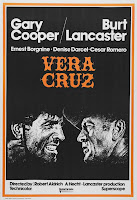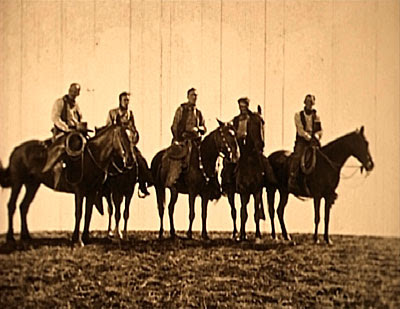Out of the Past
 In "Shades of Black and Brown: Visions of Mexico and Mexican-Americans in 1940s Film Noir", Eric Enders comments that for Jacques Tourneur's classic noir Out of the Past "Mexico provide[s] a momentary escape from the harsh realities of urban America," and that the movie's protagonists, Robert Mitchum's Jeff Markham and Jane Greer's Kathie Moffat, spend much of the film "trying to, as Greer’s character puts it, 'go back to Acapulco and start all over as if nothing had ever happened.'"
In "Shades of Black and Brown: Visions of Mexico and Mexican-Americans in 1940s Film Noir", Eric Enders comments that for Jacques Tourneur's classic noir Out of the Past "Mexico provide[s] a momentary escape from the harsh realities of urban America," and that the movie's protagonists, Robert Mitchum's Jeff Markham and Jane Greer's Kathie Moffat, spend much of the film "trying to, as Greer’s character puts it, 'go back to Acapulco and start all over as if nothing had ever happened.'"Again, then, Latin America functions as a place of escape, a potential utopia untouched by the law or, as a consequence, by crime. Enders quotes James Naremore's observation that "during the 1940s, noir characters visited Latin America more often than any other locale, usually because they wanted to find relief from repression." But as we've seen in the neo-noir The Long Goodbye (let alone Touch of Evil), things are seldom that simple. Noir characters may be endlessly crossing borders, as Naremore also observes: "to visit Latin America, Chinatown, or the 'wrong' parts of the city" ("American Film Noir" 15), but in part thanks to such endless criss-crossing, they also destabilize those borders and the comfortable distinctions such frontiers are supposed to uphold.
Precisely such a destabilization is played out within one of the Mexican scenes in this film. Markham has gone down to Acapulco in search of Moffat on the order of seedy gambling kingpin Whit Sterling (Kirk Douglas). Moffat, Sterling's mistress, had fled leaving him with a bullet in the stomach and $40,000 poorer. Markham catches up with the broad but soon falls for her, and so after a brief paradaisical romance in and around the Mexican resort, they determine to flee onwards, to ensure that Sterling can't trace and come after them. On the day of their departure, Markham hears a knock on his hotel room door. Opening it expecting his visitor to be Moffat, he discovers instead Sterling plus henchman Joe Stephanos. Markham is forced to do a visible double take: he'd expected something quite different on the other side of the door. But instead of romance and the promise of escape, he finds trouble and a reminder of all he had thought to have left behind. In short, you never quite know what's on the other side of a border, behind the door.
And though it might be nice to imagine, as Moffat suggests, that Latin America represents the one site of relief and sunshine (when she and Markham first meet in an Acapulco cantina, she is described as "coming out of the sun"), noir trades in uncertainty, leaving no respite even far from home. After all, can we even believe Moffat's utopian promises? Her line to Markham is just one among many: she's endlessly stringing him along, and as likely as not to turn on him once again in an instant. The discourse of Latin utopianism is figured clearly as yet another element in the complex web that North American characters weave among themselves.

So the point is not (as Enders suggests) whether noir movies portray Latin America benignly or otherwise. The point is how they self-consciously present discourses of Latin Americanism (or, here, also either small town or rural contentment) as one more means by which US modernity consoles itself with the possibility of an outside, even as it destroys any such division between inside and out.
Image Link: a very extensive collection of stills.
YouTube Link: the scene in which Moffat declares "I want to go back to Mexico".

















